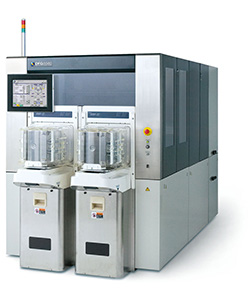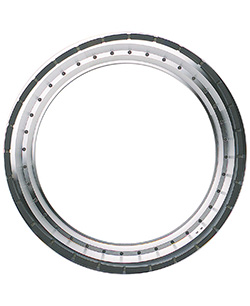Grinding Process Using Wheels
Grinding
Process outline of the grinding process using wheels
Grinding is a processing method that targets a flat substrate that is approx. a few mm thick, and uses a grinding wheel (wheel for the purpose of grinding) to make the target thin and flat.
A grinding wheel is a whetstone that uses synthetic diamonds as abrasives, and the whetstone (width: few mm, height: approx. 3 - 5 mm) is set along a ring-shaped base. There are various models that have different abrasive sizes, bonds, and whetstone thicknesses.

This grinding wheel is attached to the processing axes so that it is parallel to the table surface and then rotated at high speeds, and by pressing the wheel against the processing target substrate at a constant speed, the entire surface becomes thin and flat.
Using a grinding wheel that has the same or a slightly larger diameter than the processing target at a position such that half of the processing target is in contact with the wheel, processing is performed while rotating both the grinding wheel and the table (in-feed grinding).
During processing, water (city water or pure water) is supplied to the target in order to cool the processing point and to remove grinding particles. By using a slightly conical table, the area where the wheel and the processing target come into contact during processing becomes a half-crescent shape. Processing marks (saw marks) are created on the processed surface, and the roughness of the processed surface differs depending on the abrasive size of the grinding wheel.
For semiconductor wafers, as the backside to the surface on which circuit formation has been done is ground during the wafer thinning process, it is called backside grinding (backgrinding, BG). When a substrate that is a few hundred μm thick is ground down to a specified thickness, if the thickness is more than 100 μm then the risk of breakage is not high, but when thinning down to a thickness less than 100 μm, the risk of breakage becomes high. Therefore, the thinning process requires a special approach, such as thinking about the substrate transfer method within the equipment, or choosing appropriate grinding wheel models.
Precision processing equipment used
-

Fully Automatic Grinder
Fully automatic grinding process equipment using a wheel
-

Automatic Grinder
Automatic grinding process equipment using a wheel
Fully Automatic Grinder
The fully automatic grinders that are currently being sold come with various automation functions. Mainly, transfer, thickness measurement within the equipment, and cleaning functions are installed, and the target material can be managed per cassette. If using the grinder for the thinning process, transfer parts for the thinning process will be added.
Automatic Grinder
These processing equipment require an operator to supply the target to be processed and perform cleaning. An internal thickness measurement function can be additionally installed.
Precision processing tools used
Main targets of the grinding process using a wheel
- Thinning and grinding of semiconductor wafers
- Thinning and grinding of semiconductor packages
- Thinning and grinding of devices that use all types of electronic or optical components

